A modified version of this article appeared at http://chinaindiadialogue.com/dragon-elephant-tango-for-a-better-future
The dragon and the elephant can tango
RN Bhaskar
A modified version of this article has appeared at http://chinaindiadialogue.com/dragon-elephant-tango-for-a-better-future
Last fortnight was full of momentous developments.
First, Xi Jin Ping got elected for a third term as President of the People’s Republic of China (https://www.reuters.com/world/china/chinas-parliament-elects-xi-jinping-chinas-president-2023-03-10/).
Second, President Xi accused the US of trying to encircle China (https://www.smh.com.au/world/asia/xi-urges-officials-to-fight-accuses-us-of-encircling-china-20230307-p5cq55.html) which in turn resulted in Twitter highlighting this statement even more (https://twitter.com/RnaudBertrand/status/1632897746339516416?s=20).
Ironically, may forgot that this is not the first time that the US has been trying to encircle countries. The most momentous was the manner in which it encircled Japan before the Second World War, which in turn provoked Japan to bomb Pearl Harbour to get the US ships rush back to their home country. The US finally won the war by bombing Hiroshima and Nagasaki.
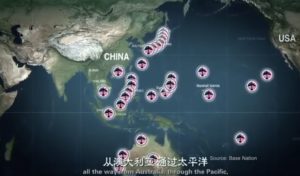 The US has been trying to encircle China for a long time. Nothing shows this more starkly than award winning John Pilger’s 2016 documentary on ‘The Coming War on China’ (https://vimeo.com/277068625). In that documentary he points out how the US has already been doing this (see image)
The US has been trying to encircle China for a long time. Nothing shows this more starkly than award winning John Pilger’s 2016 documentary on ‘The Coming War on China’ (https://vimeo.com/277068625). In that documentary he points out how the US has already been doing this (see image)
That in turn triggered remarks by the global media about how the US was now provoking a war like situation with China, having first done so with Russia (https://thefederal.com/opinion/after-provoking-russia-the-us-now-fingers-china-to-what-purpose/).
Meanwhile, another report (https://www.theguardian.com/world/2023/mar/02/china-leading-us-in-technology-race-in-allbut-a-few-fields-thinktank-finds) by an Australia thinktank showed that China led “in 37 of 44 technologies tracked in a year-long project by thinktank the Australian Strategic Policy Institute. The fields include electric batteries, hypersonics and advanced radio-frequency communications such as 5G and 6G.” Clearly, the China story was getting more interesting and even exciting.
But, even more interesting developments were taking on the China and India front. To understand them, one has to look at the announcements China made on 5 March 2023. It laid out several key policy-related data points (https://news.cgtn.com/news/2023-03-05/Premier-Li-delivers-2023-government-work-report-1hUX88u0tWw/index.html):
- China will expand its economy by around 5 percent in 2023.
- It aims to set its inflation target, or increase in consumer price index (CPI), at around 3 percent.
- It must create around 12 million urban jobs in 2023.
- It is targeting a surveyed urban unemployment rate of around 5.5 percent.
- The overall tariff level fell from 9.8 percent to 7.4 percent over the past five years.
- The government stated that it had stabilized the economy, steadily enhanced development quality, and maintained overall social stability in 2022, securing new and hard-won achievements in development,
By making these pronouncements, the Chinese government was effectively saying that it was open for business after a near shut down triggered by the zero-Covid policy it had embraced in the past few years.
Nor surprisingly, China was also stating that its GDP growth rates could now be expected to jump impressively, and that it would be back to its key role of creating new jobs and thus enhancing prosperity for its people.
In India, the news was not that cheerful. GDP growth rates fell to 4.4% in Q3 of 2022-23, which is lower than the estimate of 4.6% by the Bank of Baroda Economics team. Madan Sabnavis, chief economist of the team said that the major disappointment is negative growth in manufacturing which can be attributed to weak profits of this sector. The Q2 results did indicate a fall in profits due to high input costs.
China India prospects
In fact, like never before, both China and India have begun to appreciate the urgency of good relations between the two nations (https://asiaconverge.com/2022/10/geopolitics-bring-russia-india-china-closer/). In a way, the Ukraine war precipitated and accelerated the coming together of Russia India and China – or RIC as Russia foreign minister Sergey Lavrov stated in India recently (https://youtu.be/HfArU0yCO5M). Both India and China have begun to realise the need for working together.
Neither country wants the West to meddle in Asia’s affairs (notwithstanding India’s participation in the Quad). Both countries know that with increasing trade, China-India cross-border trade could easily surpass US-Canada trade ($612 bn in 2019).
India’s need will be greater, because it is more vulnerable to pressures from the West. A growing population will generate the political compulsions for more rapid growth. Even if its GDP grows at a faster rate than China, it will remain a fraction of the Chinese economy. But both can bring greater prosperity to their respective peoples by working together.
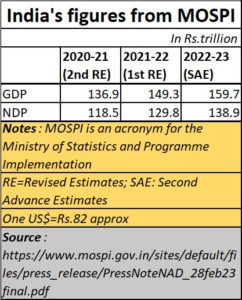 China and India account for almost 30% of global population. This region generates almost one-third of global purchasing power (https://asiaconverge.com/2023/03/india-tries-to-regain-its-balance/). And if both India and China work together, pushing up this share to almost half the global market is not inconceivable.
China and India account for almost 30% of global population. This region generates almost one-third of global purchasing power (https://asiaconverge.com/2023/03/india-tries-to-regain-its-balance/). And if both India and China work together, pushing up this share to almost half the global market is not inconceivable.
India’s imperatives
A lot will depend on India. It must learn to reduce tariffs the way China has done. That will help it reduce its high input costs.
It must stop being hypersensitive about a negative trade balance with China, because much of the imports are raw materials that go to the pharma industry. That in turn contributes to India’s exports. Without imports from China, India’s exports would also falter.
China, in turn, will have to be more sympathetic to India’s border concerns, partly because it makes sense not to rachet up tensions, and because India’s government must be wary of its electoral base.
Both countries are capable of working towards a better relationship with each other. At stake is the welfare of the two largest populations in the world. There is also the realisation that the balance of economic and even military power is rapidly shifting to the east. There is the growing need to prevent the West from poking its nose in the affairs of this region – the US will always be keen on propping up more Zelenskys in this region as well.
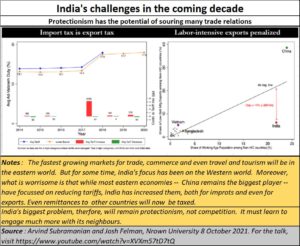 The good news is that both countries realise this. China has marked out its targets for the coming five years. India must also do this.
The good news is that both countries realise this. China has marked out its targets for the coming five years. India must also do this.
In many ways, the future of civilisation itself will depend on the mutual prosperity of RIC – Russia India and China. And for many strategists, China holds the keys.






























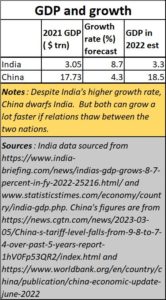
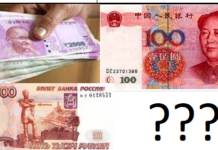







COMMENTS